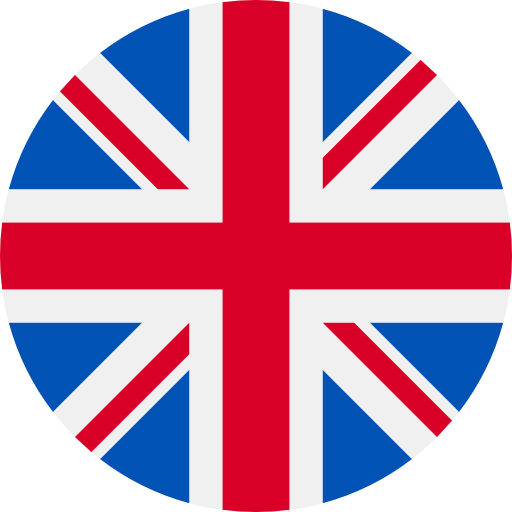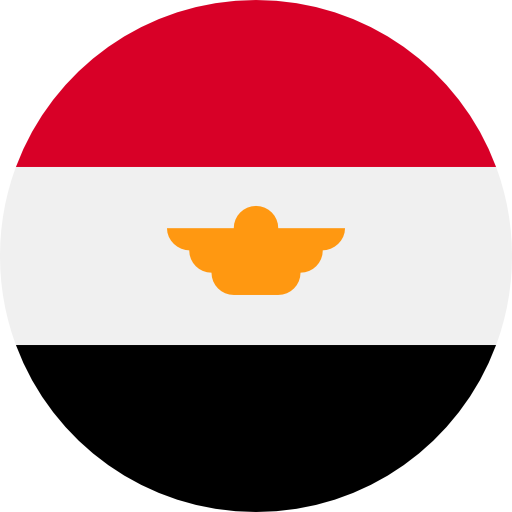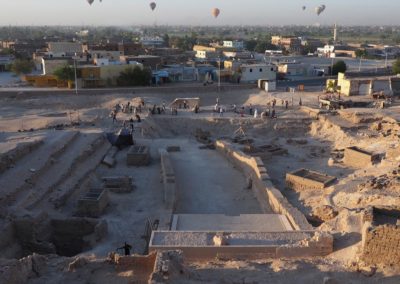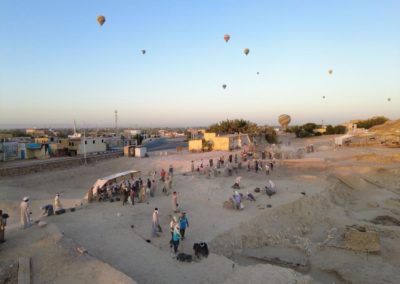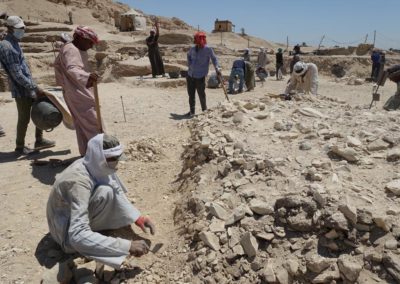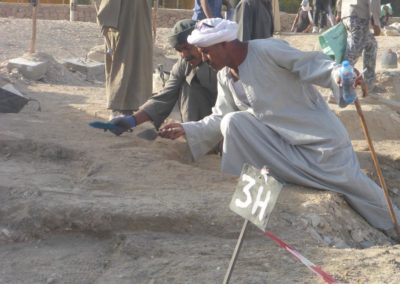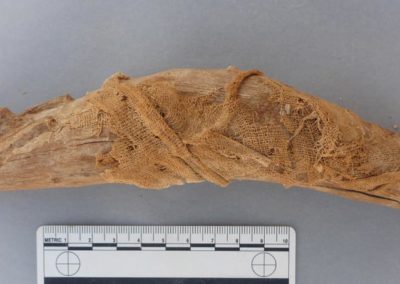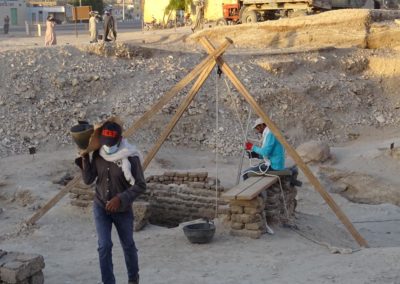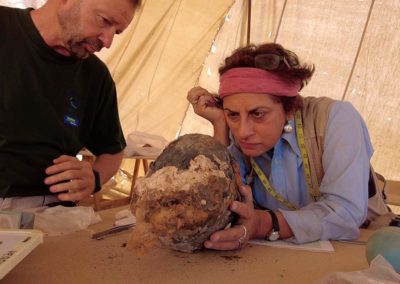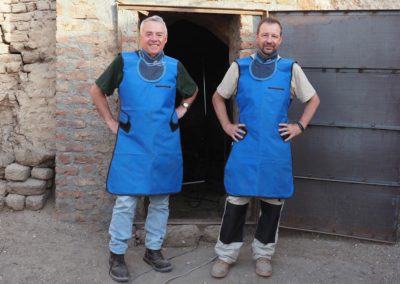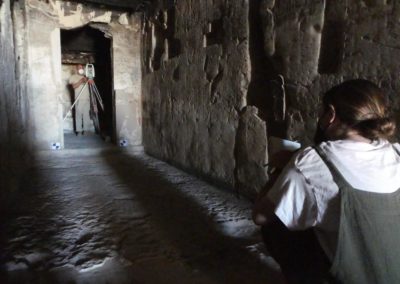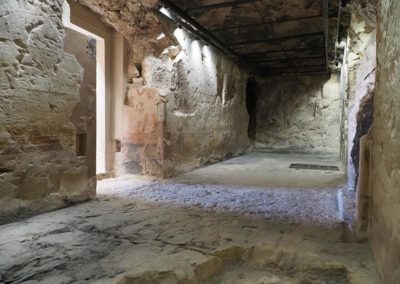Report Campaign 2021
Field Director: Dr. José M. Galán
Team Members:
- Forcadell, Ignacio Architect
- García, David Archaeologist
- González, María Pottery
- Herrerín, Jesús Physical anthropologist
- Huertas, Laura Egyptologist, archaeologist
- Ikram, Salima Egyptologist, physical anthropologist
- Ivars, Juan Architect
- Méndez, Daniel Egyptologist, epigraphist
- Oliveira, Ana Archaeologist
- Rodríguez, María Pía Conservator
- Ruiz, Carmen Photographer, epigraphist
- Sánchez, Miguel Paleopathologist
- Serrano, José Miguel Egyptologist, archaeology
- Solchaga, Maria Soledad Egyptologist
- Trueba, Javier Photographer
Acknowledgements
The Supreme Council of Antiquities in Cairo has been extremely helpful in every way, and we are most grateful to the Minister of State Antiquities, Dr. Khaled El Anani, to the General Director of Antiquities of Egypt, Dr. Mustafa Wasiri, and to Dra. Nashua Gaber, Secretary of Permanent Committee and Foreign Missions Affairs. In Luxor, as it has happened every year, the authorities responsible of the Supreme Council of Antiquities have been most helpful, in particular Mohamed Yahia Eueda, General Director of Antiquities in Upper Egypt; to General Director of Antiquities in Luxor, Gadafi Abdelrahim; to Fathy Yasin, Director of the Antiquities Department in the West Bank; to Baha Abdel Yaber, Manager of the West Bank, Qurna; and to Ramadan Ahmed Ali, Manager of all missions on the West Bank.
We have had this season Mahmoud Salman as MoA Inspector. He has been at the same time strict and vigilant, as well as most helpful and cooperative. We are, indeed, very grateful to him.
Rais Ali Farouk El-Quiftauy, as in years before, has played an important role in the success of our work. He organizes the workmen perfectly well and has a great sensibility for archaeology, for the conservation of the objects found and the structures unearthed. It is thanks to his involvement and energy that we have been able to accomplish our goals.
We have employed about 100 workmen. They have all worked very hard and with great care, and we are more than satisfied with their job.
The field season has been sponsored by (1) the Spanish Ministry of Culture, (2) the Spanish Ministry of Research and Innovation, (3) the Spanish National Research Centre, (4) Técnicas Reunidas, a Spanish Engeneering company, (4) Palarq Foundation for palaeonthology and archaeology, (5) E2IN2 Foundation and Leica Geosystems.
introduction
Dra Abu el-Naga is the modern name of the hill that rises on the West Bank at the northern end of the necropolis associated with the ancient city of Thebes, which coincides with modern Luxor. A Spanish mission has been working at the foothill of the central area of Dra Abu el-Naga since January 2002, inside and around the rock-cut tomb-chapels of Djehuty and Hery (TT 11-12).
Hery lived at the very beginning of the Eighteenth Dynasty, under King Ahmose, and probably died under his successor, King Amenhotep I. He could have been related to the royal family through his mother, Ahmes, who is referred to in the monument of her son as “adornment(?) of the king.” Hery’s administrative title mentioned in his tomb-chapel is “overseer of the granaries of the king’s mother and royal wife Ahhotep.” It must have been a relevant position since Queen Ahhotep ruled de facto as king for about twenty years, while her son was still a child and later during his campaign against the Hyksos in the Delta and into Nubia. The inner walls of his funerary monument were entirely decorated in high quality relief, being one of the very few decorated tomb-chapels that is preserved of this time period, ca. 1510 BCE.
Djehuty lived about fifty years later, ca. 1460 BCE. In the peak of his administrative career as scribe, he acted as “overseer of the Treasury” and “overseer of the works” carried out by the craftsmen and metal workers for Queen Hatshepsut, who also ruled as king for about the same time as Ahhotep. Djehuty was also “overseer of the cattle of Amun,” an office that associates him with the temple of Amun in Karnak, which is located right in front at the other side of the river Nile. The walls of his tomb-chapel were decorated in relief, even the façade and part of the left sidewall of the open courtyard. His burial chamber is also entirely written with passages from the Book of Going Forth by Day, better known as the Book of the Dead.
In the winter 2006/2007 the modern village of Dra Abu el-Naga was demolished. The following year we applied to the Ministry of Antiquities for an extension of our site in exchange of clearing the piles of debris left on the ground. The official permission was approved in 2008, and the area started to be cleared a year later. In 2011 we started the excavation of the area, southwest of Djehuty’s courtyard, which was labeled “Sector 10”. A number of mud-brick offering chapels and funerary shafts dating to the 17th Dynasty, ca. 1600 BCE, have been unearthed since then. Despite the fact that all of them were robbed in antiquity, a few objects of the original funerary equipments were retrieved. Through the inscribed objects we may rescue from oblivion some of the members of the royal family and/or the Theban elite during this period of transition, such as the king’s son Intefmose, the king’s son Ahmose, the mouthpiece of Nekhen Ahhotep, or a man called Neb, buried in a nicely painted rishi-coffin.
Excavation in sectors 10 and 11
During this season, the area of excavation was extended to the south-east of Sector 10 and the adjacent sector, labelled “Sector 11”, in front of the courtyard of the tomb-chapel of Djehuty. The ground level here is 4 m above the level of the excavated area in Sector 10 and 11. Most part of this area, which covers more than 200 m2, was used as a dump place by the houses at the northern end of the village of Dra Abu el-Naga, which was demolished in 2006.
The modern rubbish layer was assigned the Stratigraphic Unit (SU) 1000, it consisted of a dark colour soil, and the objects found in it are mainly made of plastic, fragments of alabaster related to the shops nearby, and organic material –such as straw–associated to cattle housing. This layer has not been entirely removed this season, and is still visible in squares 99A to 96A and 99Z to 96Z.
In the central part of the excavated area, underneath the layer of modern rubbish mentioned above, a new layer was identified and labelled as SU 1001. It features a lighter colour, consisting mainly of small and medium size limestone flakes. Regarding the pottery found in this layer, the chronological range is wide, as it goes from the Middle Kingdom to the contemporary era, although the larger amount dates to the Second Intermediate Period and the New Kingdom.
A mound of compacted stones of medium size, together with pottery fragments of large size and mud-bricks was unearthed in squares 97C–D and 98C–D. The pottery was mostly Second Intermediate Period and early New Kingdom. Next to it, in square 98D, a fragment of a 17th Dynasty statuette of a seated man was found. A stick-shabti with the label “For the ka of Ahmose” written on its chest was found where the squares 1G and 2G touch each other. Part of the mummy of a monkey was found in square 99C. Finally, it is worth mentioning the finding of the upper half of a 12th Dynasty paddle doll, found in square 99E.
In squares 99E–97E and 99G–97G, underneath SU 1001, another stratigraphic unit was identified, SU 1259, characterized by a darker colour with less limestone flakes. The pottery dates mostly to the Second Intermediate Period and New Kingdom. In this new layer three inscribed ostraca were found. One is a limestone ostracon, consisting of a list of workers’ names written in hieratic, in black ink. Red ink was used to cross out two of the names, and add a couple of red dots. The document dates to the 20th or beginning of the 21st Dynasty, most probably to the period known as Wehem-Mesut.
The second one is a pottery sherd, with an incomplete funerary text written in two lines, and below there are at least nine columns, which accompany a figurative composition consisting of two vaulted structures, probably standing on a boat. Inside these, Isis and Nephthys, depicted and referred to as kites, escort a coffin. The scene is labelled with the term for “grief”. The text was written on behalf of the “chief of serfs of Amun, Iy”. It seems to be a sketch design for tomb inscriptions, where the scribe was trying to convert a hieratic text into hieroglyphs, and had problems doing so.
The third ostracon shows a daily life scene divided into three registers, showing men working in a workshop on its recto. It was most probably a sketch design for a tomb figurative scene. A hieratic inscription is written in columns on its verso, mixing hieratic and hieroglyphic signs. The text mentions the “house of Amun” and a woman called Aat-nebet (or at least her name ends in these two words).
As it occurred in the stratigraphic unit above, several shabtis of Tutuya have been unearthed in this layer.
The excavation in front of the courtyard of the tomb-chapel of Djehuty, i.e. Sector 11, had as one of its aims the retrieval of written fragments from the burial chamber of Djehuty, which was decorated with passages from the Book of Going Forth by Day (i.e., the Book of the Dead). This season eight fragments with traces of writing, coming from the burial chamber of Djehuty were found.
A mud-brick structure was unearthed in squares 2I–2H, covering an area of 4.57×4.15m. Two moments of use have been documented. The original structure was built during the 17th or early 18th Dynasty, as the pottery smashed on the floor (“dakka”) clearly indicates. The purpose of the building is not completely clear, since half of its layout is not preserved. It seems that it had an entrance of 0.90m, and the interior space was 3.30×1.53m. A second use of the area dates to the 27th Dynasty, as it is clearly indicated by a large complete vase, which was found still standing up. The vessel used an incense burner as stopper. The building of the latter used smaller mud-bricks than the original one. Its layout is, unfortunately, not known, since it extends beyond the current limits of our concession.
Burial chamber of funerary shaft SU 1172
This season we only worked inside one of the funerary shafts, only for one week, trying to be as cautious as possible with the corona-virus pandemic situation and, therefore, avoiding as much as possible working in confined areas. The excavation of the funerary shaft SU 1254, which began in the previous season, was resumed and finished during this one. The shaft is located at the southern area of Sector 10, and this year the burial chamber has been completely excavated and studied. The chamber measures 2.45 x 2.10 m, and 1.28 m in height. It was filled with debris, remains of pottery and human bones. Presumably, this chamber was carved in the Middle Kingdom, but it was later reused during the 17th/early 18th Dynasties. Accordingly, the lower layer corresponds to a stratigraphic unit (SU 1253) with material culture dating to the Middle Kingdom.
Several beads of a necklace made of semi-precious stones, a small wooden box, and a coffin board with the figure of the goddess Isis painted over a yellow background were found in the chamber. Furthermore, two big jars were unearthed at the entrance of the burial chamber, typologically similar to the ones found during last season at the bottom of the shaft. The total number of jars is five. Finally, on the floor of the chamber the base of a wooden rectangular coffin was discovered. The archaeological materials, including the jars, date to the 12th Dynasty.
Epigraphy
The digital epigraphic season in the tomb-chapel of Djehuty (TT 11) has focused in the inner most room, the corridor and the transverse hall. It consisted in the digital recording of the scenes and inscriptions, following the epigraphic method of the Chicago House (Epigraphic Survey of the Oriental Institute of the University of Chicago). The first step was to identify the different elements that required to be recorded: techniques (raised and sunk relief), architectural elements (doorframes, patch stones), modern alterations (plasters, cement), holes, damages and faded areas (by water, fire, wind, salts), hacked figures and inscriptions (damnatio memoriae post-Hatshepsut reign, post-Amarna period and others), recut figures and inscriptions, additional details (colour, modelling, demotic graffiti) and ancient restorations.
Multiple photos of the walls were taken and later combined with Photoscan© in order to obtain an orthophoto. The orthophotos were later used in the drawing process as a template. Preliminary drawings were done with iPads in the tomb using Procreate© in order to check the photos directly with the actual walls. The preliminary drawing is later completed in the computer with Adobe Photoshop©, adding standardized shadows for the reliefs, and different textures for each type of wall alterations. Different layers are created for each different type of information. An important step in the process is the collation: the drawings traced the previous year by the two epigraphists are thoroughly revised in the following campaign by two other team members.
The final stage of the work entailed the digital inking in Adobe Photoshop©. This phase has already started, and the guidelines have been defined for the future publication.
Topography
As in previous seasons, Leica Geosystems lend us a topographical total station to produce accurate plans and geo-reference the photogrametries taken all over the site. We also had the chance to use a Leica Laser-scanner BLK360, to record all the tomb-chapels and funerary shafts, as well as the progress of the excavation in Sectors 10 and 11. The documentation of the structures and the excavation progress was completed by an extensive use of photogrammetry.
Conservation and Restoration
Restoration inside the tomb-chapels of Djehuty and Hery, TT 11-12, was not undertaken this season due to the “corona-virus situation”, in order to avoid having too many people working in concealed spaces. Restoration of the tomb walls will continue during the next season.
Nevertheless, one of our restorers cleaned and consolidated the preserved decorated area in the tomb-chapel of Baki, to the northeast of that of Hery (TT 12). It is a small area, but it includes part of a biographical inscription. She also cleaned and consolidated the few remains of painting in a recently discovered tomb to the southeast of the courtyard of Djehuty’s tomb-chapel (TT 11).
The lightening of the inner sections of the tomb-chapels of Djehuty and Hery was improved. The led bulbs were changed by more appropriate ones and the direction of the light was carefully tested to enhance the reliefs as much as possible.
The mouths of all the funerary shafts in the site were restored with new mud-bricks, making visually clear what is old and what is the new repair. A band of geo-textile was placed between the old and the new mud-bricks. The mouths were closed with a metal grid.
As it is done every season, the objects found in the excavation have been carefully cleaned and consolidated, and then wrapped in acid-free paper and stored in appropriate boxes.
